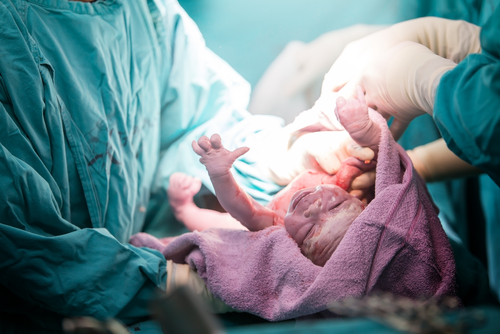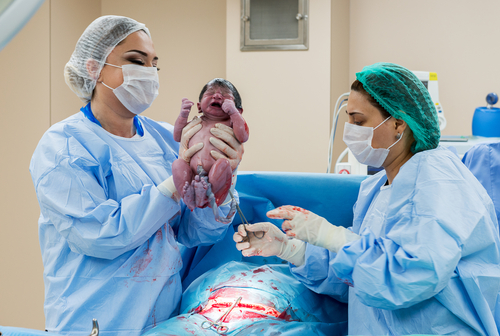toh
Third Trimester
The third trimester is a time of rapid growth and development of your babies and a rise in the risk of maternal conditions, such as hypertension or diabetes. Generally, the frequency of your clinical assessments and ultrasound surveillance also increases in the last trimester, and later in the pregnancy your doctor may request weekly or biweekly visits. The third trimester is also when fetuses have a good chance of surviving if born prematurely. You will perceive active fetal movements daily, which is an important sign that your babies are doing well. Your doctor will discuss how important it is for you to be aware of fetal movement. You must report any perceived change from normal movement to your doctor, as it means you need further fetal testing.
At approximately 36 weeks, your doctor will request a rectovaginal swab for Group B Streptococcus, which you can do yourself. This is a pathogen that a baby can acquire during its transit through the birth canal. Premature babies are more susceptible to this organism, which can lead to pneumonia or meningitis. If the swab is positive and you are planning a vaginal delivery, you will be offered antibiotic during labour to decrease the risk that your babies become infected. Your doctor will also begin planning your delivery with you and will explain special considerations for delivery of multiple babies.
The delivery of a multiple pregnancy can be more challenging than for a singleton, with more decision points. Your doctor will address with you the issues that may arise and influence the conduct of your labour and delivery.
Whether you will have a vaginal delivery or a delivery by caesarean section will depend on a number of considerations, including:
- Patient preference
- Number of babies: Triplets and more are almost always delivered by caesarean section.
- Presentation of the first baby: If the first baby is head down, the mother may usually choose to have a vaginal delivery.
- History of a caesarean section in the past, or other surgery on the uterus
- Whether there are any other pregnancy complications (high blood pressure, pre-eclampsia, HELLP syndrome, placenta previa)
- Whether the babies become stressed during labour: If the heart rate of either baby slows down, it may become essential to get them out quickly.
The obstetrician will review the options, and help you decide on the safest mode of delivery. This may need to change if the situation changes, such as one of the babies changing position or the heart rate monitor suggesting a problem during the labour process.
 The labour of twins is like singleton labour in many ways, although you will be closely monitored, including heart rates of your babies. There are usually several team members present for your delivery, including an anesthetist and an additional neonatal team ready to care for each newborn.
The labour of twins is like singleton labour in many ways, although you will be closely monitored, including heart rates of your babies. There are usually several team members present for your delivery, including an anesthetist and an additional neonatal team ready to care for each newborn.
We usually recommend an epidural for pain relief. This makes it easier to deliver your babies quickly if the babies become distressed, especially the second twin. For that same reason, we also recommend that the delivery occurs in the operating room.
The delivery of the first baby will be the same as for a singleton baby, with you pushing the baby out under your obstetrician’s guidance. Once the cord is cut, the neonatal team will check the first baby and your physician will check the position of the second baby by feeling your abdomen, doing a vaginal examination and performing an ultrasound.
Note: The placenta does not come out until after the second baby.
The second baby should be born soon after the first, as the cervix is already fully dilated. The delay between babies is usually no more than 30 minutes. If contractions stop after the first birth, you may be given oxytocin through an IV drip to restart them. The second twin may then be delivered in vertex or breech presentation, depending on the baby’s position and/or physician preference.
As with any delivery, assistance such as a suction (vacuum/ventouse) or forceps, may be needed to help the baby out, particularly if the baby become distressed.
In very rare cases, you may deliver the first twin vaginally and then need a caesarean section for the second, usually because the second twin is distressed.
 Following delivery, your doctor will ensure that you do not experience excessive bleeding from the uterus, since twin pregnancies are a risk factor for post-partum haemorrhage. Your doctor may find it necessary to administer different medications to improve the contraction of the uterus and limit bleeding. Surgical options are rarely required to achieve this.
Following delivery, your doctor will ensure that you do not experience excessive bleeding from the uterus, since twin pregnancies are a risk factor for post-partum haemorrhage. Your doctor may find it necessary to administer different medications to improve the contraction of the uterus and limit bleeding. Surgical options are rarely required to achieve this.
The early post-partum period can be challenging for a new mother as she adapts to the role of primary caregiver to a demanding newborn. There is often a period of adjustment as both mother and baby get used to each other and establish routines. Mothers of multiples may find themselves coping with several unique and unexpected issues, including separation from infants due to prematurity, need for specialized care in the intensive care nursery, increased demands of breastfeeding two (or more) infants, sleeplessness, fatigue, and increased nutritional needs.
Hospital stay is, on average, about two days after a caesarean section and one-to-two days following vaginal delivery. During this time, our expert nursing staff and lactation consultants will help guide you learn how to care for your babies, establish breastfeeding and become confident in your new role. Support for these activities in the early post-partum period continues in the community.
The Monarch Centre is an innovative multi-disciplinary maternal and newborn health clinic in Ottawa, where registered nurses, board-certified lactation consultants and family doctors specialized in maternal and newborn care offer a wide range of services. These include all necessary breastfeeding supports, bilirubin checks for jaundice and full post partum check-up and follow-up for mothers and their babies.
As your babies grow, you may find other community resources and organizations useful. The Multiple Birth Families Association and Multiple Births Canada provide advice from experienced parents who can also help locate useful items such as equipment designed for transporting multiple babies. Several Facebook groups also exist for education and support for parenting multiples.
Last updated on: April 29th, 2021


 To reset, hold the Ctrl key, then press 0.
To reset, hold the Ctrl key, then press 0.